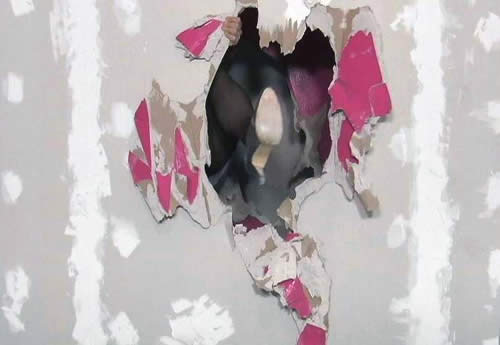This is an archive of the ArtCat Zine, 2007-2009. Please visit our new project, IDIOM.
Kate Gilmore at Smith-Stewart

Kate Gilmore
Smith-Stewart - 53 Stanton, New York NY
21 November 2008 - 18 January 2009
Kate Gilmore is a home wrecker. In the four videos on display at her Smith-Stewart debut, she kicks through layers of drywall and attacks furniture and construction materials with a sledgehammer, all while wearing high heels and dresses. As part of the exhibition, Gilmore taped herself at the front of gallery powering through two layers of drywall strewn with hot pink paper. The result of her assault in black heels and a double-breasted dress is a video called Walk This Way, which plays in a claustrophobic space directly to the side of her performance's dusty remnants. We hear the polyphonic sounds of destruction from the other videos simultaneously playing. Between a Hard Place features Gilmore in yellow spike heels, a black dress, stockings and short black gloves, again clawing through layers of gray drywall, this time coordinated with a sheet of yellow wallpaper at the journey's end. The scene recalls Charlotte Perkins Gilman's 19th century short story, The Yellow Wallpaper, about a female protagonist who is diagnosed with a "slight hysterical tendency." As treatment she is confined to her bedroom by her physician husband, where she obsesses over the patterns of the wallpaper and slowly descends into madness. In contrast, Gilmore seems relieved when she takes off her gloves and faces the camera upon reaching the end.
The joy of Gilmore's project is its lack of resolution: is there truly a breakthrough if she set the scene? The other two works continue to question her resolve, both in terms of practical objectives and physical well-being. Across from Between a Hard Place is Down the House, an aerial view of the artist standing on top of a pile of office furniture and plaster blocks splashed in red wet paint. In matching red slip-on sneakers, yellow dress and pink hair ribbon, she wields a sledgehammer to destroy the heap below her, constantly adjusting her balance. As the blocks topple over and the screen fades to black, we still hear her pound the plaster. Higher Horse again finds Gilmore considering ideas of balance and structure when she places herself atop a mountain of cement blocks that two men attempt to dismantle with mallets. We see her build herself a platform to stand upon, only to fall down and climb back up. Her pink tee shirt matches the pink wall covered with veiny, red streaks. Somewhere along the way, she loses a heel.
Gilmore's endurance -- as a sculptor, stylist, and performer -- pays homage to the studio performance tapes of artists like Vito Acconci and Marina Abramovic who, in the early1970s, made work investigating physical limits. Her explicitly gendered characters also echo the feminist narrative of the same era. Whereas Martha Rosler violently demonstrated kitchen utensils in Semiotics of the Kitchen, Gilmore practically swung a wrecking ball through the home. That spiked heel may be more dangerous than you think. Yet for all the theatricality, the artist betrays her background in sculpture with each performance. Her videos are single-take and unrehearsed. The sound of her grunts and breath is real. It's a needed counterpoint to all the artifice. Given the tremendous constraints under which New Yorkers live -- our tiny, overpriced studios, curious roommates, and so on -- an expansion of living space is wish fulfillment. If it takes a little hysteria or high heels, so be it, if it gets the job done.
ZINE
HOME
TIPS / COMMENTS
CATEGORIES
CONTRIBUTORS
- Greg Afinogenov
- B. Blagojevic
- Adda Birnir
- Susannah Edelbaum
- Julie Fishkin
- Paddy Johnson
- Jessica Loudis
- Christopher Reiger
- Andrew Robinson
- Peter J. Russo
- Blythe Sheldon
- S.C.Squibb
- Hrag Vartanian
